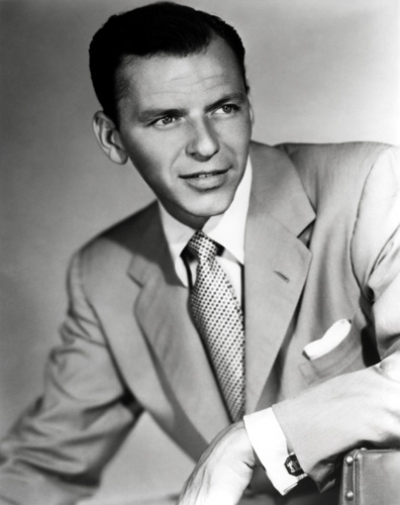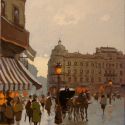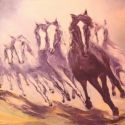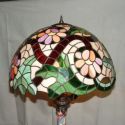
Foto: 1
Biography
Early life
He was born in Hoboken, New Jersey. He was the only child of quiet Sicilian fireman father, Anthony Martin Sinatra (1894-1969). Anthony had emigrated to the United States in 1895. His mother, Natalie Della Gavarante (1896-1977), was a talented, tempestuous Ligurian, who worked as a part-time abortionist. She was known as "Dolly", and emigrated in 1897. Although it is part of the Sinatra folklore that Frank had an impoverished childhood, he was actually brought up in middle-class surroundings, due to his father's secure job as a fireman, and his mother's strong political ties in Hoboken.
Career
Frank Sinatra decided to become a singer after hearing Bing Crosby on the radio. He began singing in small clubs in New Jersey and eventually attracted the attention of trumpeter and band-leader Harry James.
Frank Sinatra, 1947
After a brief stint with James, he joined the Tommy Dorsey Orchestra in 1940 where he rose to fame as a singer. His vast appeal to the "bobby soxers", as teenage girls were called, revealed a whole new audience for popular music, which had appealed mainly to adults up to that time. (The complete span of his career with Dorsey was released in the 1994 box set The Song Is You.) It was as a featured singer with Dorsey that Sinatra made his earliest film appearances, such as the 1942 Eleanor Powell/Red Skelton comedy, Ship Ahoy in which the uncredited singer performed a couple of songs.
He later signed with Columbia Records as a solo artist with some success, particularly during the musicians' recording strikes. Vocalists were not part of the musician union and were allowed to record during the ban by using a cappella vocal backing.
Of this first phase of Sinatra's career, it can be said that it anticipated virtually every phase of what, in the 1960s, would be called "the youth movement." His sudden--and for many his alarming--appeal to teen-agers became a topic of journalistic and even sociological comment. Subsequent musical idols would pass through the same stages of massive initial appeal, decline, and retrenchment. Few, however, would manage, as Sinatra did--and as became essential to any popular music career that aspired to longevity--to generate new audiences, as Sinatra did in the 1950s and repeatedly into even the final decade of his career.
Sinatra's singing career was in decline in the late 1940s and early 1950s, a period when novelty tunes became popular with audiences and during which Sinatra's aging would cause some loss of appeal to new teen-age audiences. Nor was his career helped by the bad publicity that comebacks in the history of American show business, Sinatra would succeed not merely in reestablishing his popularity but in taking it far beyond what he had achieved in the 1940s. This renewal would come about not in the recording studio but in Hollywood.
Sinatra had begun appearing in movies in the early 1940s, but usually in musicals, often undistinguished ones. He also appeared on a weekly television show on CBS for two years from 1950-1952 (and would try again for one year on ABC from 1957-1958).
What might be called Sinatra's second career began as a full-fledged dramatic actor when he played the scrappy Pvt. Angelo Maggio in the eve-of-Pearl Harbor drama From Here to Eternity (1953), for which he won a Best Supporting Actor Academy Award. This role and performance became legendary at the time as the key comeback moment in Sinatra's career. Virtually overnight, his career had recovered.[2]
The following year, Sinatra played a crazed, coldblooded assassin determined to kill the President in the thriller Suddenly (available freely online here); critics found Sinatra's performance one of the most chilling portrayals of a psychopath ever committed to film. This was followed in 1955 by his portrayal of a heroin addict in 1955's The Man with the Golden Arm, for which he received an Academy Award Best Actor nomination.
Frank Sinatra with Ella Fitzgerald
Soon after From Here to Eternity, Sinatra's singing career rebounded. During the 1950s, he signed with Capitol Records, where he worked with many of the finest arrangers of the era, most notably Nelson Riddle, Gordon Jenkins, and Billy May, and with whom he made a series of highly regarded recordings. By the early 1960s, he was a big enough star to start his own record label: Reprise Records. His position with the label earned him the long-lasting nickname "The Chairman of the Board".
The famous Sinatra comeback is the stuff of American legend, and, indeed, there seemed little in either his 1940s film career or his radio and television performances of the early 1950s to predict the dramatic success he would enjoy on screen in the 1950s and 1960s. However, the musical turnaround should not have been unexpected. At the very end of his Columbia recording career, in two performances in 1952 Sinatra had given advance warning of what would become the new sound he achieved in the 1950s at Capitol. In "The Birth of the Blues" it would be the sound of the new and "swinging" Sinatra: a hipper, tougher, more masculine persona than the sometimes boyish Sinatra of the 1940s. In "I'm A Fool To Want You" he anticipated the darker, melancholic sound of the great "torch" albums of the 1950s. Neither performance was sufficient to prevent Columbia from failing to renew his contract, in what must surely rank as one of the great errors in the business history of American popular music.
In the 1950s and 1960s, this new Sinatra would become the most popular attraction in Las Vegas, the venue of choice for performers of his era as the rise of rock and roll began to reduce the market for their recordings. He was friends with many other entertainers, including Dean Martin, Sammy Davis, Jr, actor Peter Lawford, comedian Joey Bishop, and sometimes Shirley MacLaine. They formed the core of the Rat Pack, a loose group of entertainers who were friends and socialized together--and whose wild and unpredictable antics would dominate show business news for much of the period 1958-63.
Sinatra played a major role in the desegregation of Nevada hotels and casinos in the 1960s. Sinatra led his fellow members of the Rat Pack in refusing to patronize hotels and casinos that denied service to Sammy Davis Jr., a black man. As the Rat Pack became the subject of great media attention due to the release of the film Ocean's Eleven (1960), many hotels and casinos, desiring the attention that would come from the presence of Sinatra and the Rat Pack in their properties, relented on their policies of segregation.
A street named in his honor in Las Vegas, Frank Sinatra Drive, opened around 2001, which parallels between Interstate 15 and Las Vegas Boulevard.
Sinatra was close to the Kennedy family and was a friend and strong supporter of President John F. Kennedy. Years later, Sinatra's youngest daughter Tina would state that Sinatra and mob figure Sam Giancana had helped Kennedy win a crucial primary election in 1960 by helping to deliver the union vote. [3] Sinatra is said to have introduced Kennedy to Judith Campbell, who had been a girlfriend of both Sinatra's and Giancana. Campbell allegedly began a relationship with Kennedy; eventually Attorney General Robert F. Kennedy became alarmed and told his brother to distance himself from Sinatra. [4] Sinatra would lose his Nevada casino license in 1963 when Giancana was seen in the Cal-Neva Lodge casino, of which Sinatra was a part owner. [5]
Frank Sinatra as Maj. Bennett Marco in The Manchurian Candidate, 1962.
Sinatra resumed his strong film work with the 1962 paranoid classic The Manchurian Candidate, in which he plays the troubled, frequently blinking, but nonetheless resolute protagonist. In 1965's Von Ryan's Express, Sinatra added dimensionality to a World War II action role. Other film appearances during this time were either cameos or, as in the case of 1964's Robin and the Seven Hoods, critically-panned efforts to trade in on his image.
In the 1970s Sinatra staged a retirement and several comebacks, recording less frequently but continuing to perform in Las Vegas and around the world. It was a period during which, by taking to the road again, Sinatra sought to bring the great American songbook of the 1920s and 1930s to a much wider audience than the one that frequented the casinos of Las Vegas.
In 1981 Sinatra's Nevada casino license was reinstated after hearings by the Nevada Gaming Control Board. Indeed, journalist Pete Hamill wrote in his book, Why Sinatra Matters, that Sinatra was "the most investigated American performer since John Wilkes Booth."
"Sure, I know some of those guys," Sinatra himself said. "I spent a lot of time in saloons. And saloons are not run by the Christian Brothers. There were a lot of guys around, and they came out of Prohibition, and they ran pretty good saloons. I was a kid. I worked in the places that were open. They paid you, and the checks didn't bounce. I didn't meet any Nobel Prize winners in saloons. But if Francis of Assisi was a singer and worked in saloons, he would've met the same guys."
In 1986, investigative journalist Kitty Kelley published a biography of Sinatra entitled His Way: The Unauthorized Biography of Frank Sinatra. Sinatra went to court to try to prevent it from being published, bringing a $2 million lawsuit against her because he believed that the book painted him in an unattractive light, and he accused her of misrepresenting herself as his authorized biographer. He later withdrew his lawsuit amid much publicity and the book went on to become number one on the New York Times best seller list and was a huge seller not only in the US but also in England, Canada, and Australia. Another Sinatra nemesis, the Hollywood gossip columnist Rona Barrett, came closer to a depiction of his character in her roman a clef, The Lovo-maniacs, which attempted a fictional insight into his complex personality. Another book Sinatra might have prevented from being published had he still been alive is "Mr S: The Last Word on Frank Sinatra" (2003), co-written by his valet George Jacobs.
Sinatra's singing career continued into the 1990s, most notably with his commercially-successful Duets albums on which he sang with other stars such as U2's Bono. He continued to perform live until February 1995, but the nearly 80-year-old singer often had to rely on teleprompters for his lyrics, to compensate for his failing memory.
Marriage and family
Sinatra was married to his childhood sweetheart, Nancy Barbato, in Jersey City, New Jersey on February 4, 1939. They had three children together: Nancy Sinatra (born June 8, 1940), Frank Sinatra, Jr. (born January 10, 1944), and Christina "Tina" Sinatra (born June 20, 1948). Although Sinatra did not remain faithful to his wife, he was by many accounts a devoted father. However, his affair with Ava Gardner became public and the couple was separated in 1950. They were divorced on October 29, 1951 despite Nancy Sr.'s (as she was sometimes known) religious qualms and objections. According to public reports Frank and Nancy Sr. remained on at least civil terms, if not better, and Nancy would recount how Frank still loved her cooking and would send someone by to pick up her home-made specialties many decades after they separated.
Sinatra married the actress Ava Gardner on November 7, 1951, only ten days after his divorce from his first wife became final. They were separated on October 27, 1953 but were not divorced until 1957. She was considered to be his truest love, but that did not guarantee marital success and stability in Hollywood.
Sinatra asked actress Lauren Bacall, whom he had been seeing since shortly after her husband Humphrey Bogart died in 1957, to marry him, but reneged when word of their relationship became public.
On December 8, 1963, Frank Sinatra, Jr. was kidnapped. Sinatra paid the kidnappers' $240,000 ransom demand (even offering $1,000,000 if only his son would be returned, though the kidnappers bizarrely turned this offer down), and his son was released unharmed on December 10. Because the kidnappers demanded that Sinatra call them only from payphones, Sinatra carried a roll of dimes with him throughout the ordeal, and this became a lifetime habit. The kidnappers were subsequently apprehended and convicted.
Sinatra married actress Mia Farrow, 30 years his junior, in 1966. They were divorced two years later.
In 1976, Sinatra married Barbara Blakeley Marx (formerly married to Zeppo Marx), who converted to Catholicism to marry him. She remained his wife until his death, although her relations with Sinatra's children were consistently portrayed as stormy, something Nancy Sinatra (Jr.) confirmed when she publicly claimed that Barbara had not bothered to call Frank's children even when the end was near, although they were close by, and the children missed the opportunity to be at their father's bedside when he died.
Alleged organized crime links
Left to right: Paul Castellano, Gregory DePalma, Sinatra, Tommy Marson, Carlo Gambino, Aladena Fratianno, Salvatore Spatola, Seated: Joseph Gambino, Richard Fusco, in 1976
Sinatra has been frequently linked to members of the Mafia and it has long been rumored that his career was aided behind the scenes by organized crime.[6]
Comedian Jackie Mason has alleged that after mocking Sinatra in his routine, he received threats and his hotel room was shot up in his presence. After he continued, he received death threats and was roughed up and his nose was broken.
J. Edgar Hoover apparently suspected Sinatra over the years, and Sinatra's file at the FBI ended up at 2,403 pages[7], detailing allegations of extortion against Ronald Alpert for $100,000. Sinatra publicly rejected these accusations many times, and was never charged with any crimes in connection with them.
Death
A frequent visitor, property owner and benefactor in the Palm Springs, California area, Sinatra wished to be buried in the desert he grew to love so much.
Frank Sinatra died at the age of 82 of a heart attack in Los Angeles, California, following a long battle with coronary heart disease, kidney disease, bladder cancer, and dementia.
His funeral was held on May 20, 1998 at the Church of the Good Shepherd in Beverly Hills. Sinatra's last words were (according to his daughter Nancy Sinatra, as told to Variety senior columnist, Army Archerd): "I'm losing."
Sinatra was buried a few miles away from Palm Springs next to his parents in Desert Memorial Park in Cathedral City, a quiet, unassuming cemetery near his famous compound in Rancho Mirage, California, which is located on the beautiful, tree-lined thoroughfare that bears his name.
His longtime friend, Jilly Rizzo, who died in a Rancho Mirage car crash in 1992, is buried nearby as is pop star, former Palm Springs mayor and Congressman, Sonny Bono.
On the day he died while on his way to the hospital traffic was lighter than usual because many people were at home watching the final episode of Seinfeld.
Legend has it that Sinatra was buried with a flask of Jack Daniel's whiskey, a roll of ten dimes (in reference to the kidnapping of his son, see above), a lighter (which some take to be a reference to his mob connections) and a packet of Camel cigarettes. The words The Best is Yet to Come are imprinted on his tombstone.
Recorded legacy
Influences
Sinatra's vocal style represented a significant departure from the 'crooning' style of his early idol, Bing Crosby. Sinatra's generation represented the first generation of children that had grown up in the era of the microphone, and the amplification of sound enabled singers to sing in a much softer, much more nuanced style. Crosby had begun this change, and established a new American singing style based around conversational ease.
However Sinatra, as he himself once noted, sang more, by which he meant that he introduced a bel canto sound to the tradition begun by Crosby. And, more importantly, he might be said to have brought the Crosby tradition to artistic completion, taking it to levels of intensity and depth of feeling that, because of the displacement of the Crosby-Sinatra tradition by rock and roll and subsequent genres, are unlikely to be achieved again.
Two other great performers of the 1930s and 1940s were significant influences on Sinatra: Billie Holiday and Mabel Mercer. Sinatra regularly heard "Lady Day" in New York clubs in the 1940s and learned from her the importance of authenticity of emotion. From Mercer he learned the importance of the element of "story" in a song. For Sinatra a song is a 3-4 minute narrative — sometimes even the story of himself, his own life, his own heartaches, his own feelings of buoyancy — and this is why Ella Fitzgerald could say of him, "With Frank, it's always this little guy, telling this ... story." The archetypal examples of the Sinatra song as story could later be found in two selections from his 1958 Capitol LP Frank Sinatra Sings For Only The Lonely: "Angel Eyes" and "One For My Baby (And One More For The Road)".
Genres
Sinatra would certainly have been considered a 'pop' singer before the rock and roll era, and the epithets Traditional Pop or more specifically Classic Pop have perhaps been coined to describe Sinatra's style.
There still exists a much wider debate, as with Ella Fitzgerald, as to whether Sinatra is a jazz singer. Certainly he performed with the finest jazz musicians, and largely performed material from the Great American Songbook. There are very few occasions when Sinatra was recorded scat singing, but minor nuances and slight derivations from the vocal line are a hallmark of the material he recorded, and he is also known for his impeccable jazz timing and phrasing. Indeed, it is impossible to imagine the Sinatra of the great years after 1953 without the influence of jazz. It is no accident that he would be Lester Young's ideal singer in the band Young had hoped to lead, nor that Miles Davis identified Sinatra's phrasing as an influence on his own. The list of Sinatra's jazz admirers is long and stellar, including such figures as Count Basie, Stan Getz, and Oscar Peterson. The question of his status as a "jazz singer" has never seemed to matter as much to such artists as it has to critics and academicians. [8]
Songs and albums
Sinatra left a vast legacy of recordings, from his very first sides with the Harry James orchestra in 1939, the vast catalogs at Columbia in the 1940s, Capitol in the 1950s, and Reprise from the 1960s onwards, up to his 1994 album Duets II.
Some of his best known recorded songs include:
Great American Songbook entries such as "Night and Day", "I've Got You Under My Skin", and "Fly Me To The Moon"
Comic numbers such as "Love and Marriage" (used as theme for American television comedy Married... with Children)
Torch songs such as "One for My Baby", "Angel Eyes", and "Drinking Again"
"It Was a Very Good Year" and "Summer Wind", which capture his mid-1960s persona of sentimental nostalgia
"That's Life", "My Way", and "New York, New York", which convey his late-stage attitude of bombastic defiance.
Three of his songs made #1 on the Billboard Hot 100 even after the advent of the rock and roll era: "Learnin' the Blues" (1955), "Strangers in the Night" (1966), and "Somethin' Stupid" (1967), the last a duet with daughter Nancy.
Of all his many albums, At the Sands with Count Basie, which was recorded live in Las Vegas in 1966, with Sinatra in his prime, backed by Count Basie's big band, remains his most popular and is still a big seller. Whether in nightclubs, casinos, arenas, or stadiums, Sinatra was one of the most mesmeric entertainers of the Twentieth Century, capable of turning the largest venue into a simulacrum of an intimate club. There are, however, few recordings or videos of his concerts. In addition to the Sands performance with Basie, three performances of Sinatra at the very peak of his career were captured: With Red Norvo Quintet: Live In Australia, 1959, Sinatra '57 In Concert, a performance in Seattle with an orchestra conducted by Nelson Riddle and Sinatra and Sextet: Live in Paris, recorded in June of 1962.
In the Wee Small Hours, 1955 — an early concept album.
Sinatra is also credited with putting out perhaps the first concept albums. 1955's In the Wee Small Hours is the prime example: a set of songs specifically recorded for the album, using only ballads, organized around a central mood of late-night isolation and aching lost love (supposedly due to his separation from Ava Gardner), with a now-classic album cover reflecting the theme. Rolling Stone magazine later named In the Wee Small Hours as #100 [9] on their list of the 500 best albums of all time.
The following year's Songs For Swingin' Lovers took an alternate tack, recording existing pop standards in a hipper, jazzier fashion, revealing an overall exuberance; Rolling Stone placed it #306 [10] on the above list.
It was the advent of the long-playing record that opened the door to these famous concept albums of the 1950s, but Sinatra's first efforts in this direction go back to the Columbia years and The Voice, when the 78 rpm disc made "album" less of a metaphor than it would become with the single-disc LPs of the 1950s.
Other Sinatra milestone albums include 1965's September of My Years, which according to critic Stephen Holden, "summed up the punchy sentimentality of a whole generation of American men," 1973's comeback album Ol' Blue Eyes Is Back, and 1980's Trilogy: Past Present Future, an ambitious triple album using three arrangers that attempted to portray the past, present, and future of his career. For many Sinatra admirers, 1981's She Shot Me Down is the last great Sinatra album. A collection of what Sinatra called "saloon songs", it includes Alec Wilder's "A Long Night", in a performance that can stand the test of comparison with the work Sinatra did in his Capitol years.
Awards and legacy
Sinatra won ten Grammy Awards during his career, including Album of the Year for Come Dance With Me in 1959, September of My Years in 1965, and A Man and His Music in 1966, and Record of the Year for "Strangers in the Night" in 1966. (The Grammy Awards only began in 1958, after two peaks of Sinatra's recording career had already happened.)
In addition, Sinatra was named the Down Beat readers' poll Male Singer of the Year sixteen times between 1941 and 1966 and the Personality of the Year six times between 1954 and 1959, and was named the Down Beat critics' poll Male Singer of the Year twice, in 1955 and 1957. Sinatra was also named the Playboy Jazz All-Star Poll Male Vocalist of the Year seven times between 1957 and 1963. [11]
In 2001 BBC Radio 2 named Sinatra as the "Greatest Voice of the Twentieth Century". [12]
Sinatra was inducted into the Big Band and Jazz Hall of Fame in 1980.
Stephen Holden wrote for the 1983 Rolling Stone Record Guide:
"Frank Sinatra's voice is pop music history. [...] Like Presley and Dylan—the only other white male American singers since 1940 whose popularity, influence, and mythic force have been comparable—Sinatra will last indefinitely. He virtually invented modern pop song phrasing."
Two decades later, radio personality and musician Jonathan Schwartz's assessment in a 2005 book review for the New York Observer showed that Sinatra's musical reputation had not diminished:
"I believe, based on a lifetime of consideration, that Frank Sinatra was the greatest interpretive musician this country has ever produced."
Discography
Chronological list of songs and albums recorded by Frank Sinatra
Alphabetical list of songs recorded by Frank Sinatra
Filmography
Major Bowes Amateur Theatre of the Air (1935) (short subject)
Las Vegas Nights (1941)
Ship Ahoy (1942)
Reveille with Beverly (1943)
Show Business at War (1943) (short subject)
Upbeat in Music (1943) (short subject) (scenes deleted)
Higher and Higher (1944)
Road to Victory (1944) (short subject)
Step Lively (1944)
The All-Star Bond Rally (1945) (short subject)
Anchors Aweigh (1945)
The House I Live In (1945) (short subject)
MGM Christmas Trailer (1945) (short subject)
Till the Clouds Roll By (1946)
It Happened in Brooklyn (1947)
Screen Snapshots: Out-of-This-World Series (1947) (short subject)
Lucky Strike Salesman's Movie 48-A (1948) (short subject)
The Miracle of the Bells (1948)
The Kissing Bandit (1948)
Take Me Out to the Ball Game (1949)
On the Town (1949)
Double Dynamite (1951)
Meet Danny Wilson (1952)
Screen Snapshots: Hollywood Night Life (1952) (short subject)
From Here to Eternity (1953)
Suddenly (1954)
Young at Heart (1954)
Not as a Stranger (1955)
Finian's Rainbow (1955) (animated musical, recorded songs with Louis Armstrong and Ella Fitzgerald, film never completed)
Guys and Dolls (1955)
The Tender Trap (1955)
The Man with the Golden Arm (1955)
Carousel (1956) (recorded several songs, shot several scenes, walked off set and was replaced by Gordon MacRae)
Screen Snapshots: Playtime in Hollywood (1956) (short subject)
Meet Me in Las Vegas (1956) (Cameo)
High Society (1956)
Johnny Concho (1956)
Around the World in Eighty Days (1956)
The Pride and the Passion (1957)
The Joker Is Wild (1957)
Pal Joey (1957)
Kings Go Forth (1958)
Some Came Running (1958)
Invitation to Monte Carlo (1959) (documentary)
A Hole in the Head (1959)
Premier Khrushchev in the USA (1959) (documentary)
Never So Few (1959)
Can-Can (1960)
Ocean's Eleven (1960)
Pepe (1960) (Cameo)
The Devil at Four O'Clock (1961)
Sergeants 3 (1962)
The Road to Hong Kong (1962) (Cameo)
Advise and Consent (1962) (voice)
The Manchurian Candidate (1962)
The List of Adrian Messenger (1963) (Cameo)
Come Blow Your Horn (1963)
4 for Texas (1963)
Robin and the 7 Hoods (1964)
A Tribute to the Will Rogers Memorial Hospital (1965) (short subject)
None But the Brave (1965) (also producer and director)
Von Ryan's Express (1965)
Marriage on the Rocks (1965)
The Oscar (1966) (Cameo)
Cast a Giant Shadow (1966)
Assault on a Queen (1966)
Think Twentieth (1967) (short subject)
The Naked Runner (1967)
Tony Rome (1967)
The Detective (1968)
Lady in Cement (1968)
Dirty Dingus Magee (1970)
That's Entertainment! (1974)
Rene Simard in Japan (1974) (documentary)
The First Deadly Sin (1980)
Cannonball Run II (1984)
Listen Up: The Lives of Quincy Jones (1990) (documentary)
In Person (1993) (voice) (short subject)
Samples
Download sample of "Saturday Night (Is the Loneliest Night of the Week)"
See also
List of popular music performers
Sinatra Doctrine
Best selling music artists
1920 US Census with Sinatras
1930 US Census with Sinatras
1992 film Sinatra
References
The New Rolling Stone Record Guide, Rolling Stone Press, 1983.
"Frank Sinatra — Through the Lens of Jazz", Jazz Times Magazine, May 1998
Friedwald, Will. Sinatra! The Song Is You: A Singer's Art. Da Capo Press, 1999.
Granata, Charles. Sessions with Sinatra: Frank Sinatra and the Art of Recording. Chicago Review Press, 1999.
Hamill, Pete. Why Sinatra Matters. Back Bay Books, 2003.
Lahr, John. Sinatra. Random House, 1997.
Mustazza, Leonard, ed. The Frank Sinatra Reader. Oxford University Press, 1997.
Mustazza, Leonard, ed. Frank Sinatra and Popular Culture. Praeger, 1998.
Pugliese, S., ed. Frank Sinatra: "history, Identity, And Italian American Culture ". Palgrave, 2004.
Rockwell, John. Sinatra: An American Classic. Rolling Stone, 1984

































